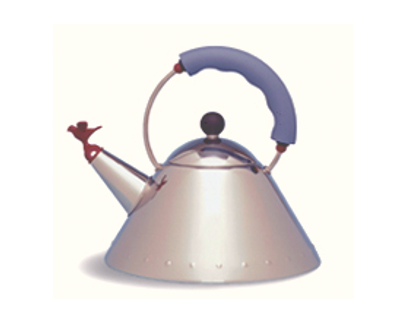Why would some people pay over $100 for a teakettle when you can boil water just as well with one that costs only $20?
That is exactly what many people have done to make Michael Graves' Alessi teakettle a long time best-seller. It boils water; it whistles as steam builds up, it is easy to use; the handle does not get hot... In short, it does everything that many teakettles do equally well.
So, what makes Mr. Graves' design so special? "It makes me smile," said one user. Apparently she is not alone.
How many of you thought — even remotely — that "makes me smile" could be a customer need for a teakettle design?
Michael Grave’s Alessi teakettle
What does "looks good" mean?
"What looks good? For me, what looks good is what 'feels' good," renowned architect Michael Graves was quoted as saying in a newspaper interview. [The Ann Arbor News, Oct. 30, 2003]
Anyone who has come to appreciate Mr. Graves' stylish works, be it a teapot or architecture, knows this is a man who understands a good design—the kind of design that a gifted and trained artist knows how to do instinctively.
But what about the rest of us? Not everyone is blessed with such artistic aptitude, and that includes many of us who are in the field of product and business process development, quality, and marketing. Additionally, not all companies can afford to hire talent like Mr. Graves in addition to maintaining their regular pool of engineering, design and development staff.
Fortunately, we have two tools to compensate: QFD and Kansei Engineering. Both can provide on the artist's sixth sense, so to speak, in a unique way to your fuzzy front end of product design.
Artists' Sixth Sense for Engineers
Kansei focuses on understanding customers' emotional and sensory needs about a product or service and identifies unique attributes of these needs that can be used by the project team. It opens the door to an area which traditionally belonged to art and psychology, disciplines in which many of us do not specialize.
Kansei techniques include category classification, semantic differential, traditional QFD tools such as affinity and other diagrams, surveys, statistical analysis, etc. These techniques help developers identify a "metaphor" concept for the new product, as well as detailed specifications to address emotional and lifestyle needs of the customer.
QFD, on the other hand, identifies "unspoken" customer requirements out of the vague verbatim "looks good" through its systematic Voice of Customer (VOC) analysis and deployment processes, focusing more on the functional needs of the customer and providing a comprehensive system to align the development efforts with the goals of the company and project throughout the development process and the entire organizational system.
QFD and Kansei Engineering complement each other. QFD cab provide on functional superiority and a powerful system-wide execution of identifying "unspoken" customer requirements, translating them into technical requirements, and establishing priorities where greatest benefits can be achieved for the effort made. QFD and Kansei can make the product inspirational and fun. In Modern QFD, this is called Lifestyle QFD.
Kansei Engineering Workshop
Attendees of the QFD Institute's Kansei Engineering Workshop will take part in a Kansei experiment and will be introduced to:
Kansei Engineering methods, including market segment-oriented development of Kansei needs and Kansei Engineering arithmetic;
Case studies and the latest international research;
Kansei software options that are available today;
How to begin applying Kansei methods on your next project.
This Workshop is typically held as an in-company custom-tailored training.
Kansei Engineering and Lifestyle QFD are also partially covered in QFD Green Belt® Course, and in more details in QFD Black Belt® Course.
For inquiry, please contact us.

